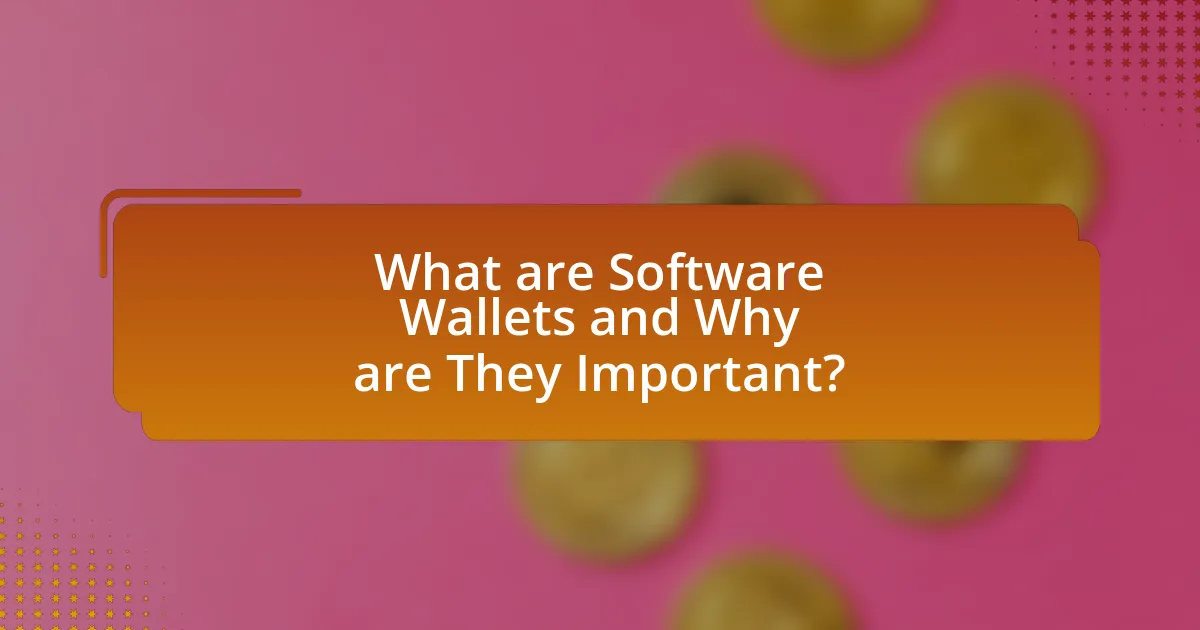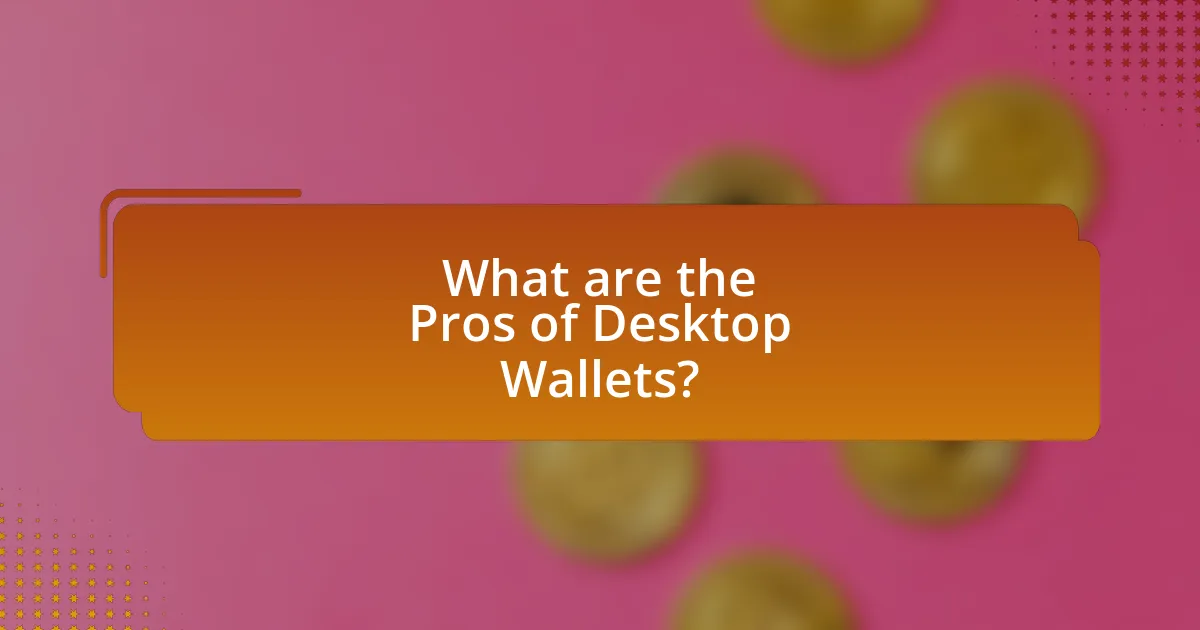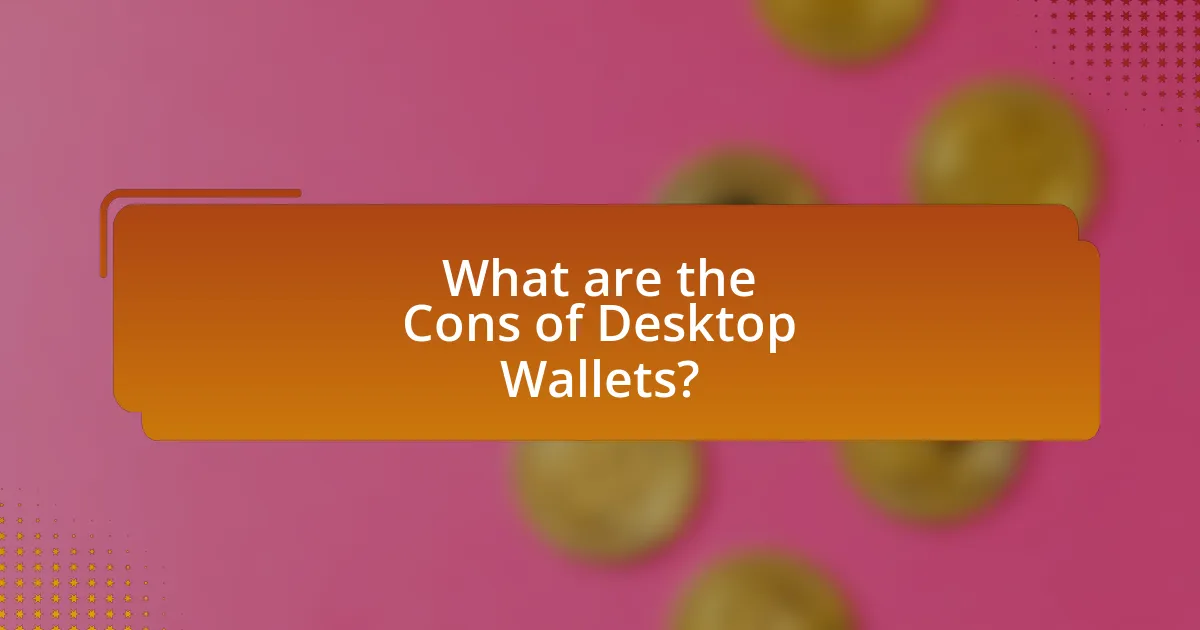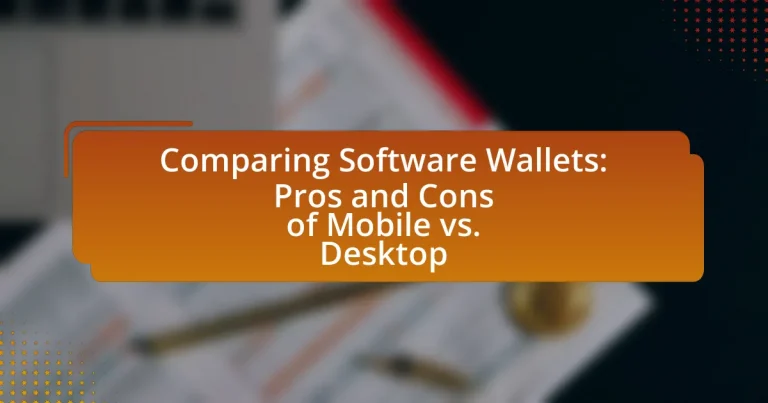The article focuses on comparing software wallets, specifically mobile and desktop wallets, highlighting their pros and cons. It defines software wallets as digital applications for storing, sending, and receiving cryptocurrencies, emphasizing their importance in the cryptocurrency ecosystem. Key differences between mobile and desktop wallets are discussed, including security features, accessibility, and user experience. The article also outlines the main types of software wallets, their key features, and the advantages and disadvantages associated with each type, providing insights into user preferences and best practices for secure usage.

What are Software Wallets and Why are They Important?
Software wallets are digital applications that allow users to store, send, and receive cryptocurrencies. They are important because they provide a user-friendly interface for managing digital assets, enabling easy access and transactions. According to a report by Statista, as of 2021, over 300 million cryptocurrency users globally rely on software wallets for their transactions, highlighting their significance in the cryptocurrency ecosystem.
How do Software Wallets differ from Hardware Wallets?
Software wallets differ from hardware wallets primarily in their storage method and security features. Software wallets, which can be mobile or desktop applications, store private keys on the device or in the cloud, making them more convenient for frequent transactions but also more vulnerable to hacking. In contrast, hardware wallets are physical devices that store private keys offline, providing enhanced security against online threats. According to a report by the Blockchain Research Institute, hardware wallets are considered one of the safest options for long-term cryptocurrency storage due to their offline nature, while software wallets are favored for their ease of use and accessibility for everyday transactions.
What are the key features of Software Wallets?
Software wallets are digital applications that allow users to store, send, and receive cryptocurrencies. Key features include user-friendly interfaces, which facilitate easy navigation and transaction management; multi-currency support, enabling users to manage various cryptocurrencies within a single wallet; and enhanced security measures, such as two-factor authentication and encryption, which protect user assets. Additionally, software wallets often provide backup and recovery options, ensuring that users can restore their wallets in case of device loss or failure. These features collectively enhance the usability and security of software wallets, making them a popular choice among cryptocurrency users.
Why choose Software Wallets over other types?
Software wallets are preferred over other types due to their balance of convenience and security. They allow users to easily access and manage their cryptocurrencies on various devices, including mobile and desktop, while still providing robust security features such as encryption and two-factor authentication. According to a report by Chainalysis, software wallets account for a significant portion of cryptocurrency transactions, indicating their widespread acceptance and reliability among users.
What are the main types of Software Wallets?
The main types of software wallets are mobile wallets, desktop wallets, and web wallets. Mobile wallets are applications installed on smartphones, allowing users to manage their cryptocurrencies on the go. Desktop wallets are software programs downloaded and installed on personal computers, providing a more secure environment for managing digital assets. Web wallets operate through web browsers, offering convenience but often at the cost of security, as they are hosted online. Each type serves different user needs, balancing accessibility and security based on the platform used.
What distinguishes Mobile Wallets from Desktop Wallets?
Mobile wallets are distinguished from desktop wallets primarily by their accessibility and user interface. Mobile wallets are designed for on-the-go transactions, allowing users to make payments and manage their finances directly from their smartphones, which often includes features like QR code scanning and NFC technology for contactless payments. In contrast, desktop wallets are typically accessed via a computer, offering a more comprehensive interface for managing larger amounts of cryptocurrency or digital assets, often with advanced features like detailed transaction histories and enhanced security options. The mobile wallet market has seen significant growth, with Statista reporting that as of 2023, over 2.8 billion mobile wallet users exist globally, highlighting their increasing popularity compared to desktop wallets.
What are the common use cases for each type?
Mobile wallets are commonly used for everyday transactions, such as making purchases at retail stores, paying for services, and transferring money to friends or family. Their portability and ease of use make them ideal for quick payments and on-the-go transactions. In contrast, desktop wallets are typically used for managing larger amounts of cryptocurrency, conducting more complex transactions, and accessing advanced features like trading and investment analysis. Their robust security measures and larger screen interface facilitate detailed management of digital assets.

What are the Pros of Mobile Wallets?
Mobile wallets offer several advantages, including convenience, security, and speed of transactions. Users can make payments quickly using their smartphones, eliminating the need for physical cash or cards. Security features such as encryption and biometric authentication enhance protection against fraud. According to a report by Statista, the global mobile wallet market is projected to reach $7.58 trillion by 2027, indicating a growing acceptance and reliance on mobile wallets for everyday transactions. Additionally, mobile wallets often provide rewards and discounts, further incentivizing their use.
How do Mobile Wallets enhance user convenience?
Mobile wallets enhance user convenience by enabling quick and easy transactions directly from smartphones. Users can make payments, transfer money, and manage their finances without needing physical cash or cards, streamlining the payment process. According to a report by Statista, mobile payment transaction value is projected to reach over $1 trillion by 2024, indicating a growing preference for this method due to its efficiency and accessibility. Additionally, mobile wallets often integrate features like loyalty programs and transaction history, further simplifying financial management for users.
What features make Mobile Wallets user-friendly?
Mobile wallets are user-friendly due to features such as intuitive interfaces, quick transaction processes, and robust security measures. Intuitive interfaces allow users to navigate easily, often incorporating visual cues and simple layouts that enhance usability. Quick transaction processes enable users to complete payments swiftly, often with just a few taps, which is essential for on-the-go transactions. Robust security measures, including biometric authentication and encryption, provide users with confidence in the safety of their financial information. These features collectively contribute to a seamless and efficient user experience, making mobile wallets a preferred choice for many consumers.
How do Mobile Wallets support on-the-go transactions?
Mobile wallets support on-the-go transactions by enabling users to make payments using their smartphones or other mobile devices, facilitating quick and convenient transactions without the need for physical cash or cards. These wallets utilize technologies such as Near Field Communication (NFC) and QR codes, allowing users to complete purchases at retail locations or online with a simple tap or scan. According to a report by Statista, the global mobile payment market is projected to reach over $12 trillion by 2025, highlighting the increasing reliance on mobile wallets for everyday transactions.
What security measures do Mobile Wallets offer?
Mobile wallets offer several security measures, including encryption, biometric authentication, and tokenization. Encryption protects sensitive data by converting it into a secure format that can only be accessed with the correct decryption key. Biometric authentication, such as fingerprint or facial recognition, ensures that only authorized users can access the wallet. Tokenization replaces sensitive card information with a unique identifier or token, reducing the risk of fraud during transactions. These measures collectively enhance the security of mobile wallets, making them a safer option for digital transactions.
How do biometric features enhance security in Mobile Wallets?
Biometric features enhance security in mobile wallets by providing unique, user-specific authentication methods that are difficult to replicate. These features, such as fingerprint scanning, facial recognition, and iris scanning, ensure that only authorized users can access the wallet, significantly reducing the risk of unauthorized transactions. For instance, a study by the National Institute of Standards and Technology (NIST) found that biometric authentication can achieve accuracy rates exceeding 99%, making it a reliable security measure. Additionally, biometric data is stored locally on devices, minimizing exposure to external threats compared to traditional password systems, which can be compromised through phishing or hacking.
What are the risks associated with Mobile Wallets?
Mobile wallets carry several risks, including security vulnerabilities, fraud, and loss of access. Security vulnerabilities arise from potential hacking incidents, where attackers exploit weaknesses in the mobile device or the wallet application, leading to unauthorized access to funds. Fraud can occur through phishing attacks, where users are tricked into providing sensitive information. Additionally, if a user loses their mobile device or it is stolen, they may lose access to their wallet and the funds within it, especially if proper security measures, such as biometric authentication or strong passwords, are not in place. According to a report by the Federal Trade Commission, consumers reported losing over $1.9 billion to fraud in 2020, highlighting the significant risks associated with digital payment methods, including mobile wallets.

What are the Pros of Desktop Wallets?
Desktop wallets offer enhanced security, as they store private keys locally on the user’s computer rather than on a server. This local storage reduces the risk of online hacking and unauthorized access, making desktop wallets a safer option for managing cryptocurrencies. Additionally, desktop wallets often provide a user-friendly interface and advanced features, such as multi-signature support and integration with hardware wallets, which can further enhance security and usability. According to a report by the Blockchain Research Institute, desktop wallets are favored by users who prioritize security and control over their digital assets.
How do Desktop Wallets provide enhanced security?
Desktop wallets provide enhanced security primarily through local storage of private keys, which reduces exposure to online threats. By keeping private keys on the user’s device rather than on a server, desktop wallets minimize the risk of hacking and unauthorized access. Additionally, many desktop wallets incorporate advanced security features such as encryption, two-factor authentication, and backup options, which further protect user assets. For instance, the use of strong encryption algorithms ensures that even if a device is compromised, the stored keys remain secure. This combination of local key management and robust security protocols makes desktop wallets a safer option for cryptocurrency storage compared to other wallet types.
What security features are unique to Desktop Wallets?
Desktop wallets offer unique security features such as local storage of private keys, which keeps them offline and less vulnerable to online attacks. This local storage minimizes exposure to malware and phishing attempts that can target online wallets. Additionally, desktop wallets often provide advanced encryption options and multi-signature support, enhancing security by requiring multiple approvals for transactions. These features are particularly beneficial for users managing larger amounts of cryptocurrency, as they reduce the risk of unauthorized access and theft.
How does the offline capability of Desktop Wallets improve security?
The offline capability of Desktop Wallets significantly improves security by preventing unauthorized access to private keys and sensitive data. When a desktop wallet operates offline, it is isolated from potential online threats such as hacking, malware, and phishing attacks, which are prevalent in connected environments. This isolation ensures that the user’s private keys remain secure and are not exposed to the internet, reducing the risk of theft. Furthermore, according to cybersecurity studies, offline storage methods, such as cold wallets, have proven to be one of the most secure ways to manage cryptocurrencies, as they eliminate the vulnerabilities associated with online transactions.
What advantages do Desktop Wallets offer for managing large amounts of cryptocurrency?
Desktop wallets provide enhanced security and control for managing large amounts of cryptocurrency. They store private keys locally on the user’s computer, reducing the risk of online hacks that can affect web-based wallets. Additionally, desktop wallets often offer advanced features such as multi-signature support and integration with hardware wallets, which further bolster security. According to a report by the Blockchain Research Institute, desktop wallets are less susceptible to malware attacks compared to mobile wallets, making them a safer option for significant holdings.
How do Desktop Wallets facilitate advanced trading features?
Desktop wallets facilitate advanced trading features by providing users with a robust interface that supports complex trading functionalities. These wallets often integrate with various trading platforms and exchanges, allowing for seamless transactions and real-time market data access. Additionally, desktop wallets typically offer enhanced security measures, such as private key storage on the user’s device, which is crucial for executing high-value trades safely. The ability to run multiple applications simultaneously on a desktop environment further enables users to analyze market trends and execute trades efficiently, making them a preferred choice for serious traders.
What tools are available in Desktop Wallets for portfolio management?
Desktop wallets offer several tools for effective portfolio management, including transaction tracking, portfolio analytics, and asset allocation features. Transaction tracking allows users to monitor their buying and selling activities, while portfolio analytics provides insights into performance metrics such as gains, losses, and overall portfolio value. Asset allocation tools help users diversify their investments by analyzing the distribution of assets across different cryptocurrencies. These functionalities enable users to make informed decisions and optimize their investment strategies.

What are the Cons of Mobile Wallets?
The cons of mobile wallets include security vulnerabilities, dependency on battery life, and limited acceptance. Security vulnerabilities arise from potential hacking and phishing attacks, as mobile wallets can be targets for cybercriminals. Dependency on battery life means that if a device runs out of power, access to funds is lost, which can be problematic in emergencies. Limited acceptance refers to the fact that not all merchants accept mobile wallet payments, which can restrict usability compared to traditional payment methods.
What security vulnerabilities are associated with Mobile Wallets?
Mobile wallets are associated with several security vulnerabilities, including unauthorized access, malware attacks, and data breaches. Unauthorized access can occur if a user’s device is lost or stolen, allowing others to access sensitive financial information. Malware attacks can compromise mobile wallets through malicious applications that capture user credentials or transaction details. Data breaches may happen when mobile wallet providers fail to secure their servers, exposing user data to hackers. According to a report by the Federal Trade Commission, mobile payment fraud has increased significantly, highlighting the need for robust security measures in mobile wallet applications.
How can malware affect Mobile Wallets?
Malware can compromise mobile wallets by stealing sensitive information such as passwords, private keys, and financial data. This occurs through various methods, including keylogging, phishing attacks, and unauthorized access to the device. For instance, a study by the cybersecurity firm Symantec reported that mobile malware incidents increased by 54% in 2019, highlighting the growing threat to mobile financial applications. Additionally, malware can manipulate transactions or redirect funds, leading to financial loss for users. Therefore, the presence of malware poses significant risks to the security and integrity of mobile wallets.
What are the implications of losing a mobile device with a Wallet app?
Losing a mobile device with a Wallet app can lead to significant security risks, including unauthorized access to sensitive financial information and potential financial loss. The Wallet app typically stores payment methods, personal identification, and transaction history, making it a target for thieves. If the device is not secured with strong authentication methods, such as biometric locks or strong passwords, anyone who finds or steals the device can easily access this information. According to a study by the Federal Trade Commission, identity theft affected approximately 1.1 million consumers in 2020, highlighting the risks associated with lost devices containing sensitive data. Additionally, users may face challenges in recovering lost funds or accessing their accounts if they do not promptly report the loss to their financial institutions.
What limitations do Mobile Wallets have in terms of functionality?
Mobile wallets have several limitations in terms of functionality, primarily related to security, compatibility, and transaction capabilities. For instance, mobile wallets often require a stable internet connection, which can hinder usability in areas with poor connectivity. Additionally, many mobile wallets do not support all cryptocurrencies, limiting users to specific digital assets. Security features, while generally robust, can be compromised if the mobile device is lost or stolen, exposing sensitive information. Furthermore, mobile wallets may have transaction limits imposed by service providers, restricting the amount that can be sent or received in a single transaction. These limitations can affect the overall user experience and functionality of mobile wallets compared to desktop alternatives.
How do Mobile Wallets compare in terms of transaction fees?
Mobile wallets typically have lower transaction fees compared to traditional banking methods and credit card transactions. For instance, many mobile wallets charge a flat fee or a percentage of the transaction amount, which can be significantly less than the fees associated with credit card processing, often ranging from 1.5% to 3%. Additionally, some mobile wallets offer free transactions for peer-to-peer transfers, making them more cost-effective for users. According to a report by the Federal Reserve, mobile payment systems have been gaining traction due to their lower costs and convenience, further validating the trend of reduced fees in mobile wallet transactions.
What features are often missing in Mobile Wallets compared to Desktop Wallets?
Mobile wallets often lack advanced security features, extensive customization options, and comprehensive transaction management tools compared to desktop wallets. Desktop wallets typically offer hardware wallet integration, multi-signature support, and detailed transaction history analysis, which are often limited or absent in mobile versions. For instance, desktop wallets can utilize more robust encryption methods and provide a larger interface for managing multiple accounts, enhancing user experience and security.

What are the Cons of Desktop Wallets?
The cons of desktop wallets include vulnerability to malware and hacking, limited accessibility, and dependency on a single device. Desktop wallets are often targeted by cybercriminals, as they store private keys on the computer, making them susceptible to attacks if the device is compromised. Additionally, desktop wallets require the user to be at their computer to access funds, which limits flexibility compared to mobile wallets. Furthermore, if the computer fails or is lost, access to the wallet may be permanently lost unless backups are maintained.
What are the potential risks of using Desktop Wallets?
The potential risks of using desktop wallets include exposure to malware, phishing attacks, and hardware failures. Desktop wallets are software applications installed on personal computers, making them susceptible to malicious software that can compromise private keys. For instance, a study by the Cybersecurity and Infrastructure Security Agency (CISA) highlighted that malware can capture keystrokes or take screenshots, leading to unauthorized access to funds. Additionally, users may fall victim to phishing attacks that trick them into revealing sensitive information. Hardware failures can also result in loss of access to funds if backups are not properly maintained. These risks underscore the importance of implementing robust security measures when using desktop wallets.
How can Desktop Wallets be vulnerable to hacking?
Desktop wallets can be vulnerable to hacking primarily due to malware infections and security flaws in the operating system. Malware can be used to capture private keys or access sensitive information stored on the device. Additionally, if the desktop wallet software is not regularly updated, it may contain unpatched vulnerabilities that hackers can exploit. According to a report by Cybersecurity Ventures, cybercrime is projected to cause damages of $10.5 trillion annually by 2025, highlighting the increasing risks associated with digital asset management. Furthermore, users often neglect basic security practices, such as using strong passwords or enabling two-factor authentication, which further increases the likelihood of unauthorized access.
What are the consequences of software bugs in Desktop Wallets?
Software bugs in desktop wallets can lead to significant financial losses, data breaches, and compromised user security. For instance, a bug may allow unauthorized access to private keys, enabling hackers to steal funds. Historical incidents, such as the 2016 hack of the Ethereum DAO, which resulted from a software vulnerability, highlight the potential for substantial monetary loss. Additionally, bugs can cause transaction failures or incorrect balances, leading to user frustration and loss of trust in the wallet provider. Overall, the consequences of software bugs in desktop wallets can severely impact users’ financial security and the overall integrity of the cryptocurrency ecosystem.
What challenges do users face when using Desktop Wallets?
Users face several challenges when using desktop wallets, including security vulnerabilities, software compatibility issues, and user experience complexities. Security vulnerabilities arise from potential malware attacks and phishing attempts, which can compromise private keys and funds. Software compatibility issues may occur due to varying operating systems and outdated software, leading to functionality problems. Additionally, the user experience can be hindered by complex interfaces and the need for technical knowledge, making it difficult for less experienced users to navigate effectively. These challenges highlight the importance of understanding the risks and requirements associated with desktop wallets.
How does the installation process impact user experience?
The installation process significantly impacts user experience by influencing the ease of access and initial engagement with the software. A streamlined installation process reduces barriers to entry, allowing users to quickly start using the software, which enhances satisfaction and retention. Conversely, a complicated or lengthy installation can lead to frustration, increased abandonment rates, and negative perceptions of the software’s usability. Research indicates that 70% of users abandon software installations that take longer than 10 minutes, highlighting the importance of efficiency in the installation phase.
What are the implications of system compatibility issues?
System compatibility issues can lead to significant operational disruptions, including reduced functionality of software wallets and potential data loss. When software wallets are not compatible with the operating system or device, users may experience difficulties in accessing their funds, executing transactions, or receiving updates. For instance, a study by the International Journal of Information Management highlights that 30% of users encounter issues due to compatibility, which can result in financial losses and decreased user trust in digital wallets. Additionally, these issues can hinder the adoption of new technologies, as users may be reluctant to switch to wallets that do not seamlessly integrate with their existing systems.
How can users choose the right type of Software Wallet for their needs?
Users can choose the right type of software wallet by assessing their specific needs, such as security, convenience, and accessibility. Mobile wallets offer on-the-go access and are ideal for everyday transactions, while desktop wallets provide enhanced security features and are suitable for managing larger amounts of cryptocurrency. According to a study by the Cambridge Centre for Alternative Finance, 40% of cryptocurrency users prefer mobile wallets for their ease of use, while 30% opt for desktop wallets due to their robust security measures. This data highlights the importance of aligning wallet choice with individual usage patterns and security preferences.
What best practices should users follow when using Software Wallets?
Users should follow several best practices when using software wallets to ensure the security of their digital assets. First, they should enable two-factor authentication (2FA) to add an extra layer of security, as this significantly reduces the risk of unauthorized access. Additionally, users must keep their software wallets updated to protect against vulnerabilities; outdated software can be an easy target for hackers.
Moreover, users should create strong, unique passwords and avoid sharing them with anyone, as weak passwords are a common entry point for cyber attacks. Regularly backing up wallet data is also crucial; this ensures that users can recover their assets in case of device loss or failure. Finally, users should be cautious of phishing attempts and only download wallets from reputable sources to avoid malware. These practices collectively enhance the security and reliability of using software wallets.


